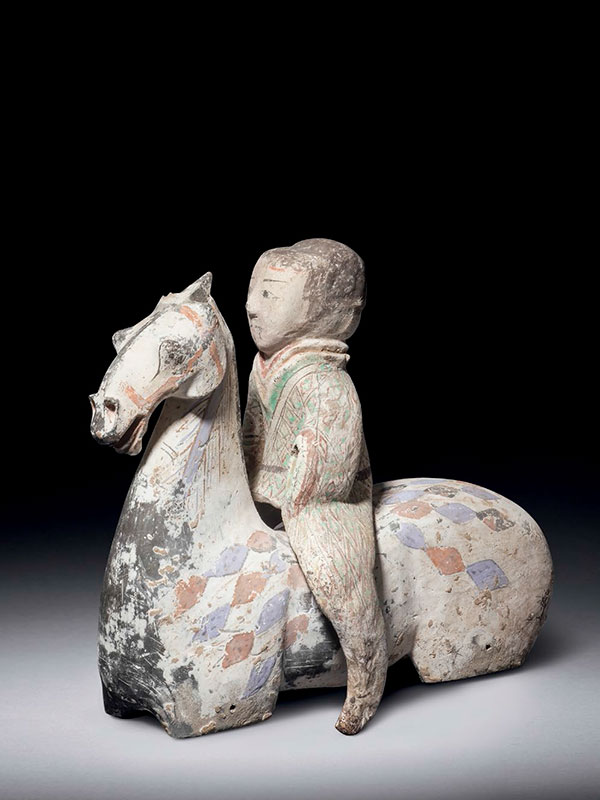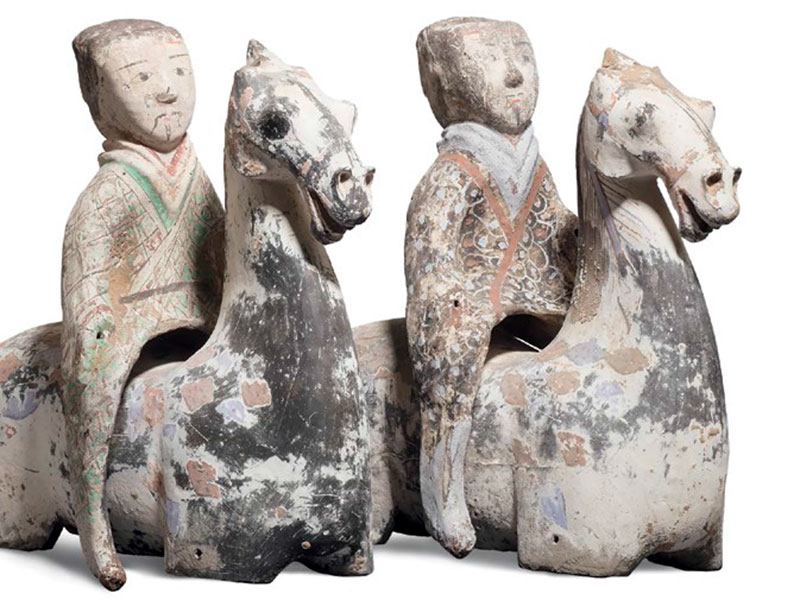Two pottery horse torsos with riders
Two painted pottery horse torsos, each with a rider. The well-modelled horses have four slots in the base where separate legs can be inserted, as well as slots for the ears and the tail. The back has a small hole for fixing the rider. The horses are brightly painted with fully detailed harnesses, lozenge patterns on the bodies and a black mane. The riders wear double robes with black belts; on one rider the outer robe has a lozenge pattern in green and red pigments and he wears white boots; on the other rider the robe has a scale-pattern in purple on a black ground and he wears purple boots. Their heads are fitted with tight black caps, which are held by a red strap. Their facial features are painted in great detail.
The practice of placing pottery models of horses in a tomb started from the Qin dynasty (221 – 207 BC) and became more widespread during the Han dynasty, particularly as a result of the Han people’s ongoing struggle against the Xiongnu, a tribe of formidable horsemen originally based in the Ordos region of present-day Inner Mongolia.[1] The riders’ armour is composed of ‘metal‘ scales, as usually worn by officers, rather than the larger square plaques worn by common soldiers. The bright purple pigment painted on the horses and riders is often found on Han pieces, together with bright green, bright pink, and bright blue. Three closely comparable Western Han pottery horses with riders, painted in similar colours and patterns, were excavated from the tomb of an important feudal lord in Shandong province and are illustrated in Horses for Eternity.[2] Horses from the Shandong region are distinguished by flamboyant surface decoration in the form of bright pigments and by the absence of legs. The underside of the body has sockets for the insertion of wooden legs, which have disappeared completely. Those similar characteristics indicate that the current examples might have come from the Shandong region as well. Another pair of pottery horses and riders, of similar size and dated to the Western Han dynasty, is in the Julius Eberhardt collection.[3]
Provenance: private collection, Europe
- Harrist Jr., R.E. Power and Virtue, the Horse in Chinese Art, China Institute in America, China Institute Gallery, New York, 1997, p. 54
- Choi, V. Horses for Eternity-Terracotta Equestrian Tomb Sculpture of Dynastic China, Dragon Culture Ltd., Hong Kong, 2007, nos. 14&5, pp. 70-1
- Krahl, R. Sammlung Julius Eberhardt, Frühe chinesische Kunst/Early Chinese Art, Vienna, 1999, no. 104, p. 176
彩繪騎馬俑一對
西漢 西元前206年 – 西元9年
長:25.4 公分 高:30.5 公分
灰陶模製陶馬及騎士俑一對,陶馬僅有軀幹及頭部,軀幹下部有四長方形孔竅,應為原四肢嵌入
處,雙耳窟及臀部亦存留孔洞。騎士俑與陶馬分離,可安置於馬上,雙腿跨坐於馬背,上身挺
立,身著鐵甲戰袍,足履長靴,臉部描繪細膩,目光直視前方。陶馬與騎士俑均罩以乳白色底
層,再敷以彩繪。其中一位騎士俑繪以菱形鎧甲,橘紅與粉綠相間,另外一位身著鱗狀鎧甲,於
黑灰底上點綴粉紫。中國自秦代以降即有以騎馬俑陪葬慣例,迄漢代大盛,應受北方匈奴多年侵
擾所影響。騎士俑一般常見身著方形網狀鎧甲,本品身著鱗狀與菱形鎧甲,應為將領等級。相似
彩繪騎馬俑曾出土於山東,亦身著鱗狀鎧甲且彩繪用色極為相似。
來源: 歐洲私人收藏


